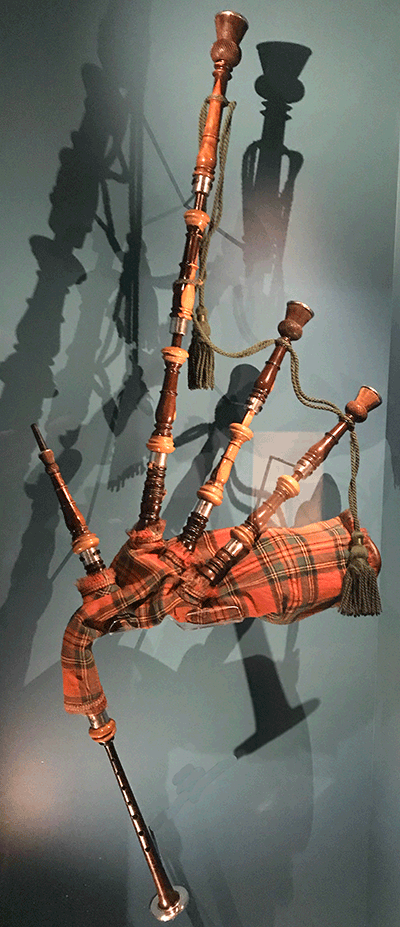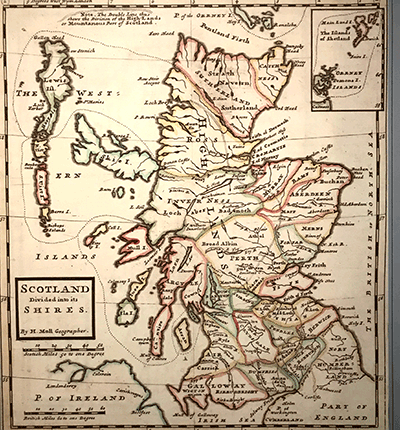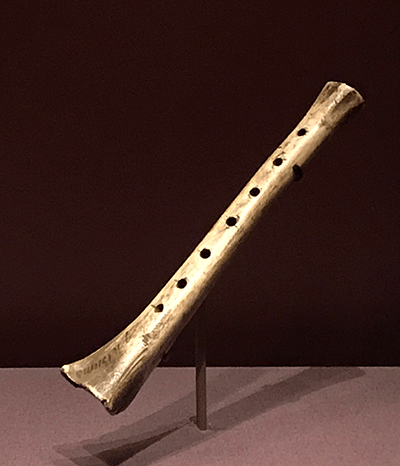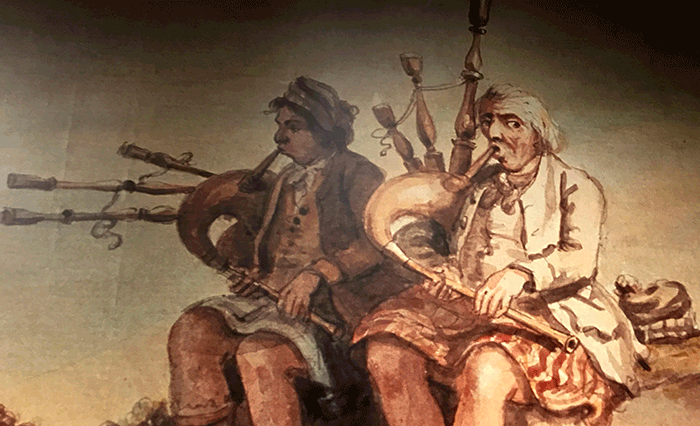
By The Editor
A new exhibition of considerable interest to pipers has opened in Edinburgh. ‘Wild & Majestic – Romantic Visions of Scotland’ debunks the myth that our tartan, our music, our kilts are all products of overblown post Jacobite and Victorian emotion.
These thriving traditions did exist in the Highlands well before the time of Sir Walter Scott and James MacPherson and were nationalised and internationalised by these writers. Home and overseas populations came to realise that the countryside was magnificent and the persecuted culture pretty darned good too.
The opening statement as you enter the National Museum of Scotland reads: ‘For the poet Lord Byron the mountainous landscapes of the Grampian Highlands inspired and emotional response, one that characterised Scotland as a land of wilderness, heroism and history…by the end of the 19th century a romantic vision of Gaelic society and history had come to stand for all of Scotland in the popular imagination….’
[wds id=”2″]
Yes, the exhibition concludes, this is a distortion of history, but it is not a wild distortion, an invention. It is based on an actualité from which the country has derived untold benefit. There was heroism; there are soaring hills and deep glens; kilts and tartan were no figment. Wrap it up in native music and song and we have a heritage most nations would die for.
Further the exhibition floor pipers will immediately be drawn to a set of 1850 laburnum pipes made by Thomas Glen, Edinburgh, and described as of ‘silver and ivory’ though I am dubious about the latter. Does ivory discolour so badly?:

I presume those thistle tops would have to be made separately and screwed on to the drone top joints.
There is an amusing line from Gaelic poet Duncan Ban MacIntyre relevant to all those pipers drifting towards ill-cut tartan breeks: ‘Since we pulled on the trousers, we despise that garment, tightening about the thighs; it’s a torment to wear; before we were confident in our belted tartan, but now our usual clothing is rags fit for a pack-horse.’ DB MacIntyre ‘A Song for the Trousers’.
Soldiers in Highland regiments played a significant role in spreading their culture. Having regular pay and a fund of stories after their travels made them respected individuals in their local communities. This encourgaed more and more young men to join up with a disproportionate number fighting Empire wars from Napoleon to WW1.

This next exhibit is described as a chanter. It does have the seven holes at the front but one can’t see if there is a high A hole. It was brought home from the braes of Atholl by Robert Burns on one of his trips to the Highlands and is described as ‘being played by a shepherd’.

Professor Hugh Cheape, who will be known to many readers, is filmed talking about piping, very impressively, in subtitled Gaelic. Hugh describes how the pipe and its music was affected by social change and speculates that it may have been deliberately altered to suit ill-informed judges.
A young piper from the Lomond & Clyde band, Eddie Seaman, is filmed playing part of the Marquis of Argyll’s Salute. Eddie is a promising player too (needs to work on his hiharin) but I wonder why the producers did not employ a professional piper to do the pipe illustrations. I hope they weren’t scrimping on the cash, the pipe the first port of call for the spreadsheet types.

Another display ‘Performing Scottishness’ notes: ‘The Highland societies were determined to reverse the decline in the use of the Gaelic language…they supported efforts to document and popularise bagpipe music, to record ancient folk tales and to publish songs and poetry….The Highland Society of London and the Highland Society of Scotland…concluded that [James Macpherson’s Ossian poems] were indeed based on genuine Gaelic oral traditions, at least in part.
‘Piping competitions organised by Highland clubs stimulated interest in Gaelic music. Local trading fairs became a focus for bagpiping and dance performances. By the first decades of the 19th century music and dance featured alongside sporting competitions in the earliest formal Highland games…’

One of the biggest boosts given to tartanalia was the 1822 visit to Edinburgh of King George IV. Lowland nobles were mocked for donning the attire of their Highland counterparts but there was no denying it was good for business. Tartan weaving boomed; everyone wanted a piper. If the kilt was good enough for the King…..
A popular ballad of the time reads:
‘Hark! the pibroch’s martial strain
Ca’s the clans to Lothian’s plain,
Scotland’s got her King again
Welcome, Royal Geordie’
In summary, this is an informative, superbly documented exhibition replete with rare and precious artefacts and memorabilia associated with a culture all pipers have now inherited. Visitors will not be disappointed, and if you are planning on attending the Piobaireachd Society’s recital in St Cecilia’s Hall on August 11 why not make a day of it by taking in this exhibition in the afternoon?
- ‘Wild and Majestic – Romantic Visions of Scotland’ runs from June 26 to November 10, 2019, in the National Museum of Scotland, Chambers Street, Edinburgh. Admission is £10 (£8.50 over 60s, £7,50 juveniles, students, unemployed, disabled). You can book at nms.ac.uk/wildandmajestic or call 0300 123 6789.















